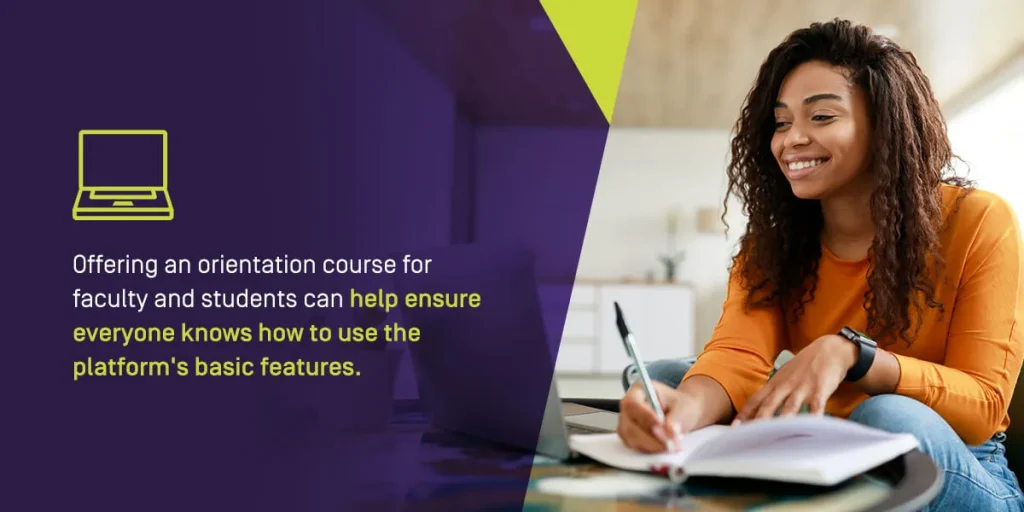




As we all recall, in the spring of 2020, campuses had to rapidly shift to online learning. Educators across the country have since found creative solutions to common distance learning issues affecting their students — here, they share their best tips and tricks.
Even after in-person classes have resumed following the COVID-19 pandemic, the majority of higher education students take at least one fully online course each semester. Following online teaching best practices can help resolve some of the frustration many educators still feel when coordinating out-of-classroom learning.
At Piedmont Community College, the shift to online instruction posed challenges with lack of time to train faculty in new mediums, equity and inclusion issues among students, and limited resources, said Don Miller, Dean of Learning Commons.
As Miller helps guide faculty into a new semester online, he has encouraged them to be creative about engaging students, since what worked in the classroom may or may not translate to online learning. Faculty at Piedmont CC are expanding their use of screen share video technology and building more interactive online courses.
According to Mercer Bufter, Academic Technology Specialist at Alamance Community College (ACC), “instructors lamented the challenges of maintaining classroom rapport and staying flexible in a chaotic time.”
As campus gears up for the fall semester, Bufter suggests implementing these three tips to start off with a good foundation in online courses:
Bufter has been impressed with how ACC faculty are adapting to online instruction this fall with new strategies such as lecture capture and sharing, planning of thoughtful sequences of online activities and creating effective synchronous virtual meetings.
Dr. Ben Shirley, Sociology instructor at ACC, is reaching out to his students before the semester even starts to ensure they are ready for online classes. Since many students will be taking online classes for the first time, he is contacting new students to the college a week before classes start and asking them to take the college’s independent distance learning orientation.
Dr. Shirley is also trying out some new technologies that can hit on a couple of different teaching modalities while providing low stakes opportunities to test out their mastery of the content.
“I’m using H5P in Moodle,” he explained. “This allows students to watch a video and get tested throughout with simple true false questions. It allows them to understand the topic in more detail, but doesn’t take a lot of time and energy from the students.”
Armed with a new license for Zoom, Alexandra Marano, English instructor at ACC, plans on polling her online literature classes for good times to meet. Once those times are set, she will offer synchronous discussions of the literature they are covering. Students who participate in the live discussion do not have to respond in writing to that week’s online forum. Marano is also going to experiment with live meetings for peer review in her online composition classes.
Laura Kassler Gaines, Computer Information Technology Instructor at ACC, is focusing on organization and automation.
“If you aren’t organized, the students have a very frustrating experience,” Gaines said. “With that in mind, less is okay. You don’t need to cram a ton of stuff into a course.”
This fall, Gaines is focusing on streamlining assessments and finding ways for students to interact and connect other than the traditional discussion forum post.
At East Central College, Anna Schwein, Computer Information Systems Faculty, struggled with getting students to connect for their team projects online in the spring.
“These are always a challenge, especially in asynchronous classes with non-traditional students because their work and family schedules vary so much as do their work habits,” Schwein said. “Since there isn’t a required meeting time each week, teams have a hard time coordinating work efforts in addition to the traditional problems associated with teamwork.”
This fall, Schwein is debating whether to introduce the big team project in the class earlier or at least put students in their teams earlier in the semester as study partners to give them time to get to know each other before the group project is assigned. With both options, she can address incompatibility in either personality or schedules earlier in the semester.
Tuition isn’t cheap, and students need to know they’re making a good investment when they choose your institution — especially when it comes to non-traditional and online learning. Implementing these four best practices in online teaching can help your institution enhance your virtual offerings to deliver the most value.

Even if instructors are familiar with the learning platform their students will use during the course, it’s always a good idea to get oriented before the term begins. Offering an orientation course for faculty and students can help ensure everyone knows how to use the platform’s basic features and troubleshoot when they run into obstacles.
Just like in traditional face-to-face settings, virtual office hours allow students to connect with instructors one-on-one outside the classroom. In addition to providing opportunities to build rapport with students, virtual office hours are great for asynchronous courses where students don’t attend live lectures.
Nontraditional students often have schedule constraints that prevent them from attending typical office hours, so faculty members might want to consider alternating hours each week. They could also offer students different ways of accessing their virtual offices, such as video chat, direct messaging, or phone call.
Textbooks and similar course materials are some of the biggest costs students will have to pay during their time at your institution, especially when it comes to STEM courses. Using open-source resources — online publications, datasets, and other materials that anyone can access and use — can help make classes more accessible and affordable for both students and instructors. While most are free, some require you to pay a small fee to use them.
Faculty should first coordinate with your institution’s library to confirm their access to restricted resources like academic journals and eBooks. It’s a good idea to reassess the materials your institution subscribes to every academic year to ensure you’re paying for ones that students regularly use. Then, to fill any access gaps, they should search for the best available open-source options that will fulfill their course content.
Personalized learning programs give students the ability to tailor their programs to their individual needs and goals, which can make education more accessible to those who also need to work or care for family. While most students thrive while following synchronous class schedules, the flexibility of asynchronous online courses makes them perfectly suited to personalized learning.
You could also offer asynchronous classes with the option to attend a live lecture. Faculty can record each class session, and students who can’t attend can watch the recording to catch up on their own time. In general, the more you’re willing to invest in your technology infrastructure, the better prepared you’ll be to provide more flexibility.
At Watermark, we’re dedicated to helping higher education institutions optimize their offerings to provide the most value to their students. Our fully integrated solutions make it easy to collect and analyze student and course data, so you can identify opportunities to improve your institution’s online, hybrid, and in-person course offerings.
Ready to get started? Contact us to learn more, or schedule a free demo to see our solutions in action.






























































































































































































































































































































































































